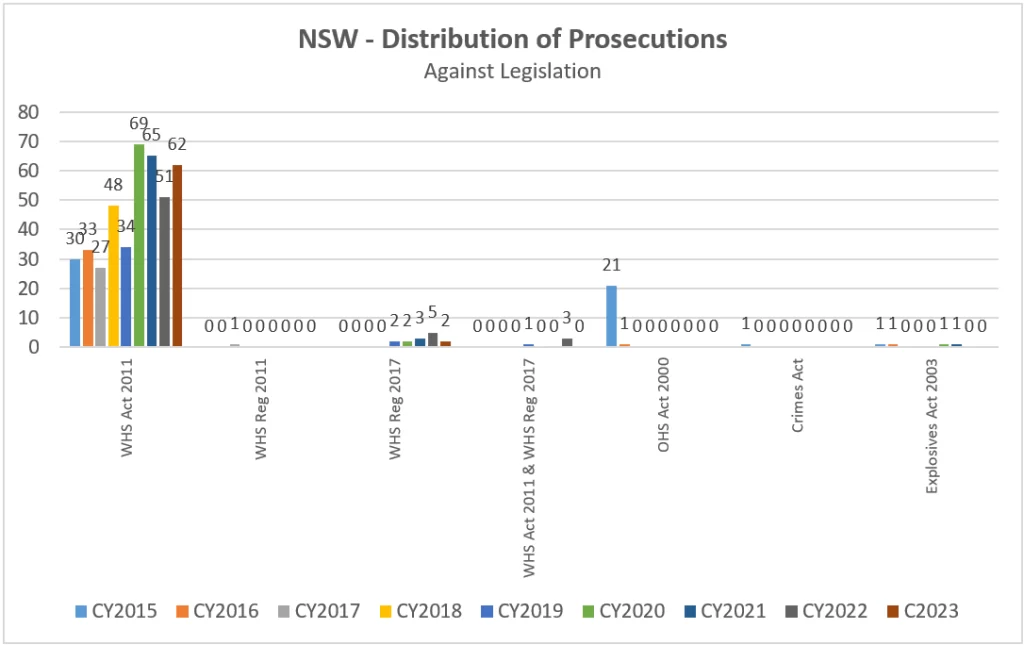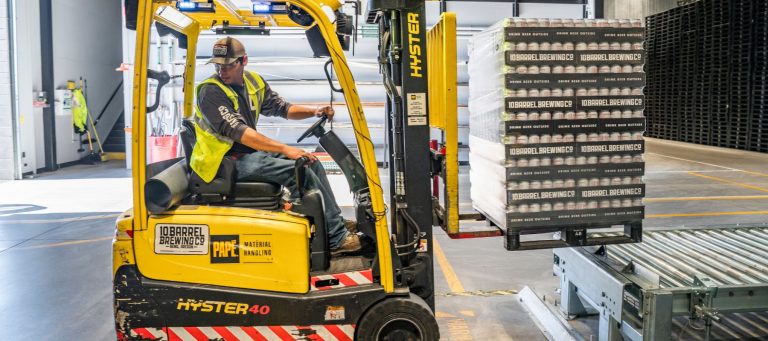Business leaders have a legislative duty to acquire and maintain up-to-date knowledge of work health and safety matters relevant to the nature of their operations. But without any visibility of the health and safety prosecutions that have occurred, it can be hard to grasp what could go wrong within your operations.
With a little context, you have an opportunity to reflect on current practices. This can help to ensure that reasonably practicable controls have been established, and to ensure ‘like’ or ‘now foreseeable’ incidents are less likely to occur within the workplace.
‘Reasonably practicable’ means that you should consider the likelihood and degree of harm of a hazard or risk. Whilst there may not have previously been an incident at your workplace, if a significant incident has occurred across your industry, you should be aware of it.
Each year, since 2015 Action OHS Consulting has collated and reviewed the data available from both WorkSafe Victoria and SafeWork NSW. Used effectively, this information should support you to influence key stakeholders within your organisation, and assist your business to make informed decisions with respect to their health and safety program.
The prosecution data has been collated from:
This article provides an overview of the prosecutions from 2015 through to the 2023 Calendar Years (CY).
Prosecutions: Numbers and related legislation
The 2023 calendar year saw a total of 137 prosecutions against the Victorian health and safety legislation, whilst in NSW the number of prosecutions was 64.
Victoria: When compared to the previous year, there has been a 19% increase in Victoria. This is compared to a 20% increase in CY2022 when compared to CY2021. CY2023 has seen prosecutions returned to pre-COVID levels. With CY2018 and CY2019 reporting 132 and 137 prosecutions respectively.
NSW: When compared to the previous year, there has been an 5% increase in NSW. This is compared to a 14% reduction in CY2022 when compared to CY2021. Prosecutions have been relatively consistent since CY2020.

Prosecutions Within Victoria:
- 116 prosecutions were recorded against the Occupational Health and Safety Act 2004 only
- 18 prosecutions involved both the Occupational Health and Safety Act 2004 and the Occupational Health and Safety Regulations 2017
- 1 prosecution involved the Occupational Health and Safety Regulation 2017 only
- 1 prosecution involved the Dangerous Goods Act 1985 only
- 1 prosecution involved the Occupational Health and Safety Act 2004 and Dangerous Goods Act 1985

Consistent with previous years, zero prosecutions were against the 2007 version of the Occupational Health and Safety Regulations which were updated in 2017.
Prosecutions Within NSW:
- 62 prosecutions were recorded against the Work Health and Safety Act 2011 only
- 2 prosecution was recorded against the Work Health and Safety Regulation 2017 only

Prosecution timeframes
The table below lists the timeframe for the prosecution’s outcomes from CY2023 when measured against the date of the offence.
Table 1: Timeframe between date of offence and the prosecution outcome, for the CY2023 prosecution outcomes reported by SafeWork NSW & WorkSafe Victoria. Bracketed numbers represent the increase / decrease when compared to 2022.

Health and safety fines
Year on year, the average fine in Victoria has more than doubled increased by 130% from $50,489 to $116,332. With respect to the median fine in Victoria this has increased by 25% from $20,000 to $25,000. This represents an increase in the value of the larger fines, and the number of larger fines. As a reference, in Victoria, during CY2022 the maximum fine was $600,000, in CY2023 there were four (4) fines greater than this [$2,900,000; $2,100,000; $1,500,000; and, $730,000] – see below.
With respect to NSW the average and median was consistent with CY2022.
Both the average and median fines were greater in NSW, when compared to Victoria. The average fine in NSW is more than double that of Victoria, whilst the median fine is more than 6x greater in NSW when compared to Victoria.

WorkSafe Victoria reported to issue five (5) Enforceable Undertakings during CY2023 which equates to 3.6% of prosecutions. This aligns with the percentage of prosecutions that resulted in Enforceable Undertaking issued in CY2022.

An ‘enforceable undertaking’ (EU) is a legally binding agreement between WorkSafe Victoria and the employer. The employer is obliged to carry out the specific activities outlined in the agreed undertaking. EUs will typically guide and direct the business being prosecuted to improve its health and safety program.
Health and safety fines: Maximum issued
The maximum fine in Victoria was circa 5x greater than in CY2022. In contrast, NSW’s maximum fine in CY2023 was consistent with CY2022.

The maximum fines issued to a business were associated with the following events:
Victoria: Bradbury Industrial Services Pty Ltd (in liquidation) (“the offender”) was a chemical waste recycling company based in Campbellfield, Victoria. In 2019, the offender operated several warehouses in the area, including locations at 16-18 Thornycroft Street, 9-11 Brooklyn Court, 20A Yellowbox Drive, 20B Yellowbox Drive, 12 Yellowbox Drive, and 1745 Sydney Road.
The offender, as an occupier of premises where dangerous goods were stored, failed to take all reasonable precautions at the Brooklyn Court, Yellowbox Drive, and Sydney Road locations, including inadequate storage methods and insufficient spill containment measures. Additionally, at the Thornycroft Street premises, the offender failed to provide necessary instruction, information, supervision, and training, leading to a serious incident.
On the morning of April 5, 2019, an employee was decanting toluene, a Class 3 Dangerous Good, when a large flash fire erupted, quickly spreading out of control. The fire destroyed the warehouse, requiring four days to extinguish and causing the closure of nearby schools. The employee sustained burns to his face and throat, requiring a three-day hospitalization.
In sentencing, the Court imposed fines totalling $2,900,000, considering the serious breaches and the guilty plea as mitigating factors.
NSW:
On 7 September 2019, a 40-year-old worker of A1 Arbor Tree Service Pty Ltd (the offender) was fatally injured when he was drawn into a woodchipper while hand-feeding branches at Lindfield.
After a SafeWork NSW investigation the defendant, A1 Arbor Tree Service Pty Ltd, was charged with a breach of section 31(1)/19(1) of the Work Health and Safety Act 2011.
The District Court convicted the defendant on 14 July 2023 and imposed a fine of $2,025,000.
It is not just businesses being prosecuted concerning health and safety breaches
Prosecutions are not limited to corporations. In 2023, authorities issued 15% and 11% of prosecutions to workers in Victoria and NSW, respectively – equating 20 and 7 prosecutions, respectively.

The average fine issued to a worker in Victoria and NSW was $52,307 and $27,392 respectively.
Prosecutions: What is the cause and where are the gaps?
With respect to the criteria/codes that lead to the prosecution – of the 59 criteria that was referenced, 13 criteria associated with more than 10% of the prosecutions in 2023; note: “Guarding” and “Failure to prepare a SWMS” were included as they have been monitored consistently over the last editions of this review.
WorkSafe Victoria defines these as outlined below:

These criteria whilst changing in distribution have been consistent since 2015.
“Failure to provide a safe working environment” and “failure to provide a safe system of work” continue to place a clear duty on all workplaces to understand their operations, the hazards associated with their work, and to ensure that they implement established controls.
Other noteworthy criteria includes:
- The introduction of “Traffic Management” to the list.
- Fatality was cited for 7% of prosecutions, or for 10 prosecutions.
- With psychosocial hazards and silica core regulator themes, it will be interesting to monitor the prosecutions in years to come that reference these criteria/codes. During CY2023: Silica = 1; Stress =1; Occupational violence and aggression = 2; Sexual Harassment = 2; Workplace bullying/harassment = 7.
Health check
Action OHS Consulting, in collaboration with its sister-company Safety Champion Software, has developed a self-assessment tool: Safety Champion Impact Assessment. This tool helps businesses understand potential points of failure, allowing them to proactively improve their health and safety program.
We plan to make this tool accessible up until 31 April 2024.
START SAFETY CHAMPION IMPACT ASSESSMENT
Free consulting support
As part of the WorkSafe Victoria OHS Essentials Program, businesses with operations in Victoria, may be eligible for three (3) OHS Consulting Support sessions delivered over 12-months by an Action OHS Consulting expert. These sessions guide businesses in delivering their legal OHS duties and obligations.
FIND OUT MORE ABOUT THE OHS ESSENTIALS PROGRAM
Key takeaways
To enable better and more informed decisions, businesses must establish processes to assess the effectiveness of their health and safety program implementation.
The Health and Safety Legislation adopts a self-regulated risk-based approach. This requires businesses and their leaders to understand potential risks within their operations and establish practical controls to minimize the likelihood or severity of such events. The intention; is to protect workers, contractors, customers and visitors from harm.
This requires leaders to be real. It requires them to appreciate that safety as documented by your policy and procedure manual, may not reflect work as completed operationally.
Put simply, this leads to a requirement for workplaces to actively:
- Ensure that your safety program is easy to access and understand, and importantly relevant to your operations. Strongly consider implementing safety software, such as Safety Champion, to help ensure the completion of scheduled tasks and enable workers to easily report incidents and hazards. Ensuring that you have visibility and read access to this information, will assist you to proactively prevent incidents from occurring in the future.
List all the ways workers could get hurt, and document what you have put in place to prevent this. Start by listing the “Top 5” hazards – focusing on those that could cause the most serious harm. Do this in consultation with a selection of workers who hold different roles within your business. If you identify things that you could improve and/or do better, this is not bad, in fact, it is the point of the exercise.
The good news is that Safety Champion has a Risk Module that helps guide the process, whilst allowing you to document the conversation.
- Continue to consult. Have regular structured and unstructured conversations with your team regarding the controls you have established.
- Build competency. Ensure that you have an induction program that includes an overview of your safety program and the operational activities. Consider assigning a buddy to new and/or young workers.
- Ensure your safety program is sustainable. If you are organized, spreadsheets and folders can be effective. However, they make it difficult to maintain visibility of due tasks and, more importantly, missed tasks.
This is where software programs like Safety Champion Software will support your organisation, providing visibility of your health and safety program in real-time, remind you when deadlines and key milestones approach, and provide you with access to data to make data-based decisions via its Module Set.
- Consider safety as part of your procurement process. Before you buy anything, consider the safety implications. Don’t limit this to equipment, machinery, computers – extended this to services as well. Don’t make safety an afterthought.
We want to hear your thoughts, questions or concerns.
Request an unlocked copy of the data. Contact Us.
Author: Craig Salter & Marcela Medina.






